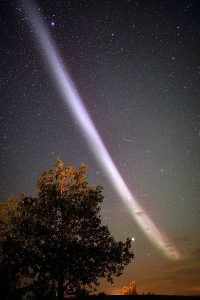
Since STEVE events happen where auroras are found, it is reasonable to think that they are related to auroras in some way. However, auroras are visible every night when you are at high latitudes and the viewing conditions are favorable. By contrast, STEVE events are visible only a few days each year, at least according to the photographers who have documented them. Also, auroras produce a glow that spreads wide throughout the night sky, while STEVE events produce ribbons of light.
So what causes these events? Currently, scientists can’t say. The initial study said they might be similar to auroras, which are caused by high-energy charged particles that have been trapped by earth’s magnetic field interacting with molecules in the upper atmosphere. This interaction gives the molecules excess energy, and they emit that energy in the form of visible light, mostly reds, greens, and blues. Scientists looked at satellite imagery that was taken during a documented STEVE event, and they did see charged particles moving at high speeds through the appropriate region of the atmosphere, but they couldn’t say for sure that they were related to the event.
Now, some of the authors of that study have published an analysis that indicates STEVE events are not very similar to auroras. They looked at imagery from the National Oceanic and Atmospheric Administration’s polar orbiting satellites that happened to be over a documented STEVE event on March 28, 2008. It was in the perfect position to see if high-energy charged particles were interacting with the upper atmosphere during the event, and it saw none.
As a result, there is currently no explanation for what causes STEVE events. I look forward to seeing where the research goes on this!

There must be something floating around the culture that makes us find the name Steve funny in this fashion; I distinctly remember doing so as a kid, and it was before the movie you mention came out.
I guess Jung would say there is an image embedded deep in human mind that associates Steve with humor…